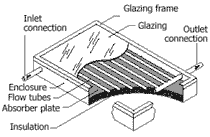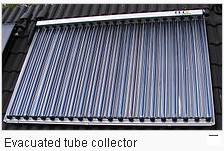Flat-plate collector – Flat-plate collectors, developed by Hottel and Whillier in the 1950s, are the most common type. They consist of (1) a dark flat-plate absorber, (2) a transparent cover that reduces heat losses, (3) a heat-transport fluid (air, antifreeze or water) to remove heat from the absorber, and (4) a heat insulating backing. The absorber consists of a thin absorber sheet (of thermally stable polymers, aluminum, steel or copper, to which a matte black or selective coating is applied) often backed by a grid or coil of fluid tubing placed in an insulated casing with a glass or polycarbonate cover. In water heat panels, fluid is usually circulated through tubing to transfer heat from the absorber to an insulated water tank. This may be achieved directly or through a heat exchanger.
A typical flat-plate collector is a metal box with a glass or plastic cover (called glazing) on top and a dark-colored absorber plate on the bottom. The sides and bottom of the collector are usually insulated to minimize heat loss.

Sunlight passes through the glazing and strikes the absorber plate, which heats up, changing solar energy into heat energy. The heat is transferred to liquid passing through pipes attached to the absorber plate. Absorber plates are commonly painted with “selective coatings,” which absorb and retain heat better than ordinary black paint. Absorber plates are usually made of metal—typically copper or aluminum—because the metal is a good heat conductor. Copper is more expensive, but is a better conductor and less prone to corrosion than aluminum. In locations with average available solar energy, flat plate collectors are sized approximately one-half- to one-square foot per gallon of one-day’s hot water use.
Most air heat fabricators and some water heat manufacturers have a completely flooded absorber consisting of two sheets of metal which the fluid passes between. Because the heat exchange area is greater they may be marginally more efficient than traditional absorbers. Sunlight passes through the glazing and strikes the absorber plate, which heats up, changing solar energy into heat energy. The heat is transferred to liquid passing through pipes attached to the absorber plate. Absorber plates are commonly painted with “selective coatings,” which absorb and retain heat better than ordinary black paint. Absorber plates are usually made of metal—typically copper or aluminum—because the metal is a good heat conductor. Copper is more expensive, but is a better conductor and less prone to corrosion than aluminum. In locations with average available solar energy, flat plate collectors are sized approximately one-half to one square foot per gallon of one day’s hot water use. Absorber piping configurations include:
- harp – traditional design with bottom pipe risers and top collection pipe, used in low pressure thermosyphon and pumped systems;
- serpentine – one continuous S that maximizes temperature but not total energy yield in variable flow systems, used in compact solar domestic hot water only systems (no space heating role);
- flooded absorber consisting of two sheets of metal stamped to produce a circulation zone;
- boundary layer absorber collectors consisting of several layers of transparent and opaque sheets that enable absorption in a boundary layer. Because the energy is absorbed in the boundary layer, heat conversion may be more efficient than for collectors where absorbed heat is conducted through a material before the heat is accumulated in a circulating liquid.
Evacuated tube collectors – Most vacuum tube collectors in use in middle Europe use heat pipes for their core instead of passing liquid directly through them. Direct flow is more popular in China. Evacuated heat pipe tubes (EHPTs) are composed of multiple evacuated glass tubes each containing an absorber plate fused to a heat pipe. The heat is transferred to the transfer fluid (water or an antifreeze mix—typically propylene glycol) of a domestic hot water or hydronic space heating system in a heat exchanger called a “manifold”. The manifold is wrapped in insulation and covered by a protective sheet metal or plastic case. The vacuum inside of the evacuated tube collectors have been proven to last more than 25 years, the reflective coating for the design is encapsulated in the vacuum inside of the tube, which will not degrade until the vacuum is lost. The vacuum that surrounds the outside of the tube greatly reduces convection and conduction heat loss, therefore achieving greater efficiency than flat-plate collectors, especially in colder conditions. This advantage is largely lost in warmer climates, except in those cases where very hot water is desirable, e.g., for commercial processes. The high temperatures that can occur may require special design to prevent overheating.

Some evacuated tubes (glass-metal) are made with one layer of glass that fuses to the heat pipe at the upper end and encloses the heat pipe and absorber in the vacuum. Others (glass-glass) are made with a double layer of glass fused together at one or both ends with a vacuum between the layers (like a vacuum bottle or flask), with the absorber and heat pipe contained at normal atmospheric pressure. Glass-glass tubes have a highly reliable vacuum seal, but the two layers of glass reduce the light that reaches the absorber. Moisture may enter the non-evacuated area of the tube and cause absorber corrosion. Glass-metal tubes allow more light to reach the absorber, and protect the absorber and heat pipe from corrosion even if they are made from dissimilar materials
Performance Analysis of A Liquid Flat Plate Collector
There are efficiency variations in collectors according to their given parameters, and also according to cost, area, and storage outlet temperature. But there is huge capacity to reduce the collector area and minimize the number of tubes which are required for water circulation in collector assembly.

